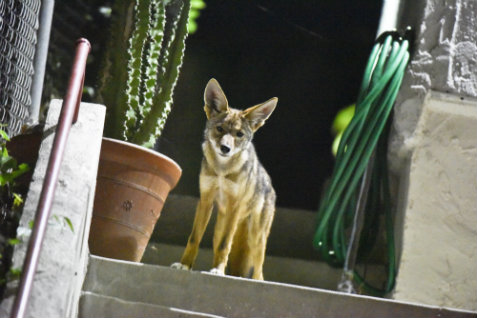We see ‘em everywhere these days. Sometimes they are as familiar as squirrels or finches. But rest assured, coyotes are indeed a different kind of animal.
Discovering how coyotes survive in an intensively urbanized area is the goal of a new research project by the National Parks Service which has been studying carnivores in and around the Santa Monica Mountains since 1996. Altogether, they have radio-tracked more than 300 bobcats, 140 coyotes and 40 mountain lions.
Researchers are now investigating the habits of urban wildlife and are looking at two recently captured and collared coyotes – C-144 and C-145 – for clues on how the canids are able to navigate streets, parklands and backyards.
“From just a few months of data, we now know that coyotes are persisting within home ranges that have high human densities and little natural habitat, which is quite remarkable,” says Justin Brown, a biologist for the Santa Monica Mountain National Recreation area.
C-144 is proving to be an interesting subject to follow. A female estimated to be two or three years old, she spends most of her time in the Westlake neighborhood, a densely populated area just west of downtown with very little natural habitat. She is currently raising at least five pups.
C-144 is believed to have one of the most urban home ranges of any coyote ever studied and has already surprised biologists by crossing the 101 Freeway several times, near where it intersects with the 110 Freeway. Decades of coyote, bobcat and mountain lion research in the Santa Monica Mountains have demonstrated that the 101 Freeway is a near-impenetrable barrier further to the west. It’s unclear whether C-144 is crossing directly over the freeway or is finding alternative methods like bridges or underpasses.
On the other hand, C-145, a male estimated to be between four and eight years of age with a home range in the Silver Lake neighborhood, has not crossed any freeways in his hood. He hangs mainly in residential areas and the little natural habit he can find.
Based on a limited analysis of GPS data for the two coyotes, researchers found that more than half of the recorded locations are in developed areas, such as along roads and in high-density residential areas. The remainder of the recorded locations were in landscapes defined as altered, such as vacant lots or parks. Whereas 77% of locations from the previous western Los Angeles County study were recorded in natural areas, defined as at least one square kilometer of natural vegetation, zero of C-144 and C-145’s GPS points met that definition.
Over time, researchers hope to learn more about how these animals are using the landscape, how much space they need and what kind of conflict, if any, they are having with humans.

